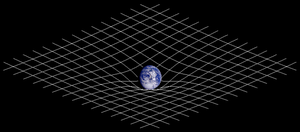
Back Graviton AF جرافتون Arabic Gravitón AST Гравітон BE Гравитон Bulgarian গ্র্যাভিটন Bengali/Bangla Graviton BS Gravitó Catalan Gravitonu CO Graviton Czech

A graviton is a hypothetical particle that 'transfers' gravitation's force (particles like this are known as gauge bosons) from its field. Gravitons have never been observed, directly or indirectly,[1] however, there have been several theories that use gravitons to explain certain phenomena. For example, a theory that describes black holes by combining quantum mechanics and gravity, has been advanced by Georgi Dvali and Cesar Gomez, which suggests a black hole is "an overpacked bucket of gravitons". There are some theories that suggest that gravitons would make up a new group of particles, "attraction particles". CERN is currently using the Large Hadron Collider to try to find this particle.
The graviton applies a tiny force as it impacts the nuclei of atoms. All atoms themselves have these graviton particles in orbit around them. If you gather a lot of atoms together the population of orbiting gravitons increases proportionately. As a result, a large asteroid for example will have more gravity than a small one. Because the graviton is a particle that has force (gravity), it is classed as a gauge boson. Other gauge bosons include the photon, the gluon, and the W and Z particles.
If someone found one, it could lead to a theory which would join the four main physical forces: electromagnetism, gravity, strong force and weak force.
- ↑ Wei, Lisa (2003). "What is a graviton?". Curious about Astronomy. Retrieved 2009-11-01.